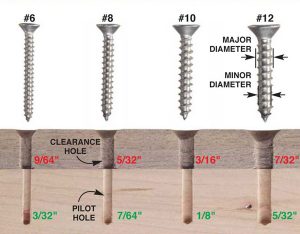Last time it was a blog about selecting table saw blades, today, drilling pilot holes. As the attached questions and answers say, pilot holes are a good idea. When you break the head off a screw there is often no real way to undo your misfortune.

Q. I think pre-drilling screw holes is a real drag, so I rarely do it. Most screws seem to work fine without all that bother. Why are you always advocating pre-drilling?
A. Call us old fashioned, but when you’re working in solid wood, we believe you’ll get the most effective and longest-lasting fastening power from screws when you drill correctly sized clearance and pilot holes.
First, drill a pilot hole through both boards. Pilot holes guarantee that your screw won’t break off and your wood won’t crack. For most hard woods, the pilot hole should be at least as large as the screw’s minor diameter. If the screw has deep threads, or the wood is very hard, the pilot hole should be another 1/64-in. larger than the minor diameter. For softer woods, the pilot hole can be 1/64-in. smaller.
Skipping the pilot hole, or drilling one too small, can create hairline cracks in solid wood and MDF. Visible cracks are obviously bad,but other cracks that are too small to see can eventually widen and cause the joint to fail.
Second, enlarge the pilot hole in the top board to make a clearance hole. This larger hole allows the screw to pull the two boards together. The clearance hole should be at least as large as the major diameter of the screw. Skipping the clearance-hole step often results in a small gap between the two boards you’re joining together. Glue won’t effectively bridge a gap larger than the thickness of a piece of paper.
We are staying in Gavle Sweden this week and today we walked along the river toward the Baltic Sea. The boating season hasn't started yet but I did see two wooden skiffs.
 |
| 18 foot lapstrake planked skiff. An old sweetie still at work. |
 |
| this boat's deck looked rough but the hull planks appeared sound, and the transom was solid too. |
This is the slightly larger, racier sister, a bit neglected and needing some TLC on the upper deck.
I took this photograph to show the shape of the planks. They are tapered toward both ends, and all the planks on one side are different. It would have been educational to see this wooden boat built.
cheers, ianw

No comments:
Post a Comment